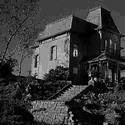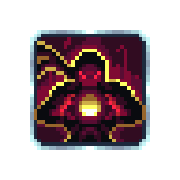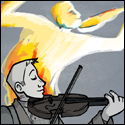|
Eggnogium posted:I read and ran DW quite a few years back but it was literally my first TTRPG experience and we (not the same players as now) totally floundered at the improv required. But I agree that taking the lesson to make (and telegraph) consequences for passivity is a good one. You can definitely do mysteries in fantasy. I feel like lots of genres benefit from a bit of information gathering or twisty plots without necessarily having to make it the whole focus of the experience. Anyways, if you want to take a small step away from 5E, 13th Age does a lot of similar things mechanically but adds in more narrative control for the players. It's more of a dial than a switch, though, so if some players are less into it, they don't need to be in the spotlight quite as much. If you want a bigger step, then Fellowship is awesome. It's built on a PbtA/Dungeon World foundation but really improves on DW. It also lets players define big chunks of the world focused around their character. If the orc player says that orcs are sentient mushroom colonies, well, that's how they are now. Another general trick I found that works well is to break out a blank piece of paper. Draw one location on it yourself to start. Then pass it around and have each player name and draw another one. The locations may or may not come up right away or be linked closely to their characters. But it's a really fun way to get the ball rolling. Splicer posted:There's a fantasy GUMSHOE game coming out in Aprilish: I played an earlier version of this at GenCon. It's a blast. I really like how it uses the Gumshoe investigative abilities for other stuff. That side of he character sheet can now be used for sorcery or social combat. In one game at GenCon, we were all playing as street urchin type kids. One of the characters unleashed an absolutely devastating social attack on an NPC by admitting she actually like liked him and he was too dense to pick up on it. The setting is very cool, too. Xiahou Dun posted:Eggnogium, fyi, DW’s MC section is very anemic and basically assumes you know AW’s section cold, so it’s not as helpful. This is a known problem with DW, up there with”god drat it, 6 stats”, “god drat, Defy Danger is a terrible bit of design space” and “the fan-made playbooks are better across the board”. Agreed. The AW chapter is really helpful. DW assumes you have a very specific sense of how the game should go and will kinda fudge its own rules to get there, in my experience. I also started with the Inverse World playbooks, which are absolutely incredible if your players are down for some weirder fantasy. The Inverse World setting is also very good, depending on how close your players want to stick to traditional versus non traditional settings.
|
|
|
|

|
| # ? May 23, 2024 17:12 |
|
I wouldn't say Strike! is that big and crunchy, it still has a lot of free-form elements in a lot of places.
|
|
|
|
Anybody know why AW isn't in print, even POD?
|
|
|
|
CitizenKeen posted:Anybody know why AW isn't in print, even POD? It's very strange. I was able to grab it in print when it was randomly available for a short while last year, thankfully, but I'm not sure why that was the case and why it's not just in stock anywhere, or, as you said, POD.
|
|
|
|
Recently on the AW Discord, Meg said they will be doing another print run eventually, and pointed folks here, where it looks like there's still copies available: https://heartofthedeernicorn.com/product/apocalypse-world-2nd-edition/?v=7516fd43adaa
|
|
|
|
Blind Azathoth posted:Recently on the AW Discord, Meg said they will be doing another print run eventually, and pointed folks here, where it looks like there's still copies available: https://heartofthedeernicorn.com/product/apocalypse-world-2nd-edition/?v=7516fd43adaa Oh, thank you. My Google-fu is weak.
|
|
|
|
Might as well cross-post from the GM thread Captain Walker posted:The game: Fantasy mid-apocalypse. The end is nigh, and most people are just kind of resigned to it, trying to find what joy they can in a dying world. The PCs, for various reasons, want to keep the world from ending.
|
|
|
|
Just a throwing-it-out-with-very-little-thought suggestion: Fellowship. It's coped very well with the wacky stuff my players have tried.
|
|
|
|
The answer to "my players want to play D&D but not D&D" is, in my experience, either Fellowship or 13th Age, depending on taste and the nuances of the table.
|
|
|
|
potatocubed posted:Fellowship. CitizenKeen posted:Fellowship DTRPG reviewer posted:Things my group did in the game I just ran: Yep, this is the one, right here
|
|
|
|
"Trying to find what joy they can" makes my thoughts turn to The Shadow of Yesterday / Solar System.
|
|
|
|
Zorak of Michigan posted:"Trying to find what joy they can" makes my thoughts turn to The Shadow of Yesterday / Solar System. This is also the base tone for Ryuutama, with the black Ryuujin. I don't know if the Ryuutama system would be a good fit, though I also like it. Tone description here: http://kotohi.com/ryuutama/translators-notes/ I would just also say that Fellowship does a great job of being open ended while feeling much less hand wavey than D&D does when you're inprov-ing rules. Sionak fucked around with this message at 22:00 on Feb 13, 2022 |
|
|
|
I was about to pay through the nose for Fellowship 2nd (I only have the base 1st), when word came down of a 3rd. I'm hoping my 13th Age campaign takes longer than for Fellowship 3rd to come out, because I'm definitely including it in the pitch deck for my next campaign. Unrelated: anybody know what's in the Wildsea Collector's Edition other than a different cover? CitizenKeen fucked around with this message at 22:06 on Feb 13, 2022 |
|
|
|
CitizenKeen posted:I was about to pay through the nose for Fellowship 2nd (I only have the base 1st), when word came down of a 3rd. I'm hoping my 13th Age campaign takes longer than for Fellowship 3rd to come out, because I'm definitely including it in the pitch deck for my next campaign. Note that Gnome is juuust in the very beginning phase of planning a 3rd version and has explicitly posted that it's way too early to publish it so soon after 2e. Also you may already have access to the 2e core if you own 1e, depending on where you bought it. Also also, if you have the core rules and you're not super interested in new playbooks or frameworks but you want a billion toys to play with in the base game, you can get by with just grabbing Generous Fellowship. (Though to be honest GF is a must-own even if you have everything else, imo)
|
|
|
|
Mirage posted:Note that Gnome is juuust in the very beginning phase of planning a 3rd version and has explicitly posted that it's way too early to publish it so soon after 2e. I've got the 2E PDF (just the main book, I kinda want all of 'em), but games don't usually hit my table without me buying the book in hardcover.
|
|
|
|
Unrelated to anything, here's a useless game design thought I recently had: Many D&D dice rolls are not actually binary, but instead follow an implicit miss/weak effect/success pattern because things are measured in feet and hit points. When you climb a wall, depending on the height of the wall in feet and your check result, you can either make no progress, some progress, or finish the climb. Similarly, when you hit an orc you can do no damage, some damage, or lethal damage. Edit: Sorry, I tell a lie. That's not how the climbing rule goes. Sorry, sorry. I was thinking of the old third edition jump rules somehow. Siivola fucked around with this message at 08:14 on Feb 14, 2022 |
|
|
|
Siivola posted:Unrelated to anything, here's a useless game design thought I recently had: Many D&D dice rolls are not actually binary, but instead follow an implicit miss/weak effect/success pattern because things are measured in feet and hit points. When you climb a wall, depending on the height of the wall in feet and your check result, you can either make no progress, some progress, or finish the climb. Similarly, when you hit an orc you can do no damage, some damage, or lethal damage. rolemaster had a great table for that, you could run a whole game off it with a bit of effort. 
|
|
|
|
The Doctor Who and Rocket Age system uses a simple degree of success system that universalizes the results of all dice rolls along a range of "No and (something gets even worrse), No, No but (you don't do it but you get some other small benefit), Yes but (your success is partial or otherwise compromised), Yes, Yes and (you do something on top of what you were initially trying for)," which I've always liked. Though, if I were designing it I'd probably remove the flat "No" result. That said, and here I'll freely admit that my knowledge of D&D mechanics ends around the early 4e era, but I wouldn't really say that "many" D&D rolls aren't binary. You can kind of make a case that an attack as a whole unit has a range of outcomes based on the damage roll, but the actual attack roll is binary (you either hit or you don't), and outside of critical hit rules, the result of the attack roll has no actual bearing on the damage roll: you're exactly as likely to roll max damage (or min damage, for that matter) on a roll that barely hits your target's AC as you are on the best possible non-crit attack roll. That's not a non-binary roll in any meaningful sense, just an action that has two stages of randomness. The closest to actual non-binary results in D&D I can think of are, as you mentioned, the 3/3.5e Jump check rules, and... maybe a Diplomacy check rule that had a floating DC to determine what reaction level NPCs had? Which if I'm not wholly imagining it, I think was also a 3.x era rule.
|
|
|
|
3e had poorly defined optional rules for critical success/fail on everything in the DMG, basically. One of Pathfinder 2e's best mechanical changes is making those a part of the core rules and not suck for everything, 10 below the DC on a d20 roll is a critical failure, +10 over the DC is a critical success. Makes the math a lot more meaningful than the usual pass/fail d20 stuff. Literally had a B/X game the other day that was just our plate dudes swinging at the enemy plate dudes seeing who was gonna roll high first for like ten rounds, then the enemies did and splattered our front line in a round and everyone else fled. A great story, fun gameplay, not great mechanics.
|
|
|
|
sebmojo posted:rolemaster had a great table for that, you could run a whole game off it with a bit of effort. I like how the absurd column lives up to its name.
|
|
|
|
GimpInBlack posted:That said, and here I'll freely admit that my knowledge of D&D mechanics ends around the early 4e era, but I wouldn't really say that "many" D&D rolls aren't binary. You can kind of make a case that an attack as a whole unit has a range of outcomes based on the damage roll, but the actual attack roll is binary (you either hit or you don't), and outside of critical hit rules, the result of the attack roll has no actual bearing on the damage roll: you're exactly as likely to roll max damage (or min damage, for that matter) on a roll that barely hits your target's AC as you are on the best possible non-crit attack roll. That's not a non-binary roll in any meaningful sense, just an action that has two stages of randomness. But like, the attack roll by itself is meaningless. Being "hit" in D&D means nothing, you need to then apply the effect of that hit, and because the effect is variable, there are more than two possible results for the action. (I'm counting "wounded but not dead" as one broad result here.) The relationship between the attack and damage isn't relevant here: Making the attack roll affect the damage roll more strongly wouldn't meaningfully increase the number of outcomes, it'd just move damage numbers around. Edit: For any given attack and damage roll, you could construct a near-equivalent d100 table that indicated whether you hit and if yes, how hard. Then you could combine several for various situations, go insane, and end up with the table sebmojo posted above. 
Siivola fucked around with this message at 10:28 on Feb 14, 2022 |
|
|
|
Siivola posted:But like, the attack roll by itself is meaningless. Being "hit" in D&D means nothing, you need to then apply the effect of that hit, and because the effect is variable, there are more than two possible results for the action. (I'm counting "wounded but not dead" as one broad result here.) The relationship between the attack and damage isn't relevant here: Making the attack roll affect the damage roll more strongly wouldn't meaningfully increase the number of outcomes, it'd just move damage numbers around.
|
|
|
|
Yeah, that's a valid way to add spice to rolls for sure. You could probably do something similar with skill checks, like having rolls divisible by 5 add a complication or something. My group's going to give PF2 a try once my Phandelver game wraps up, and I'm excited to see hot its crit system works in practice. Siivola fucked around with this message at 10:44 on Feb 14, 2022 |
|
|
|
Siivola posted:Yeah, that's a valid way to add spice to rolls for sure. You could probably do something similar with skill checks, like having rolls divisible by 5 add a complication or something. I don't see the point of dice tricks like that, if it's a mechanic triggered entirely by random chance, not one that the players can increase the odds of triggering or force to trigger or something, it just seems... garbage.
|
|
|
|
Siivola posted:My group's going to give PF2 a try once my Phandelver game wraps up, and I'm excited to see hot its crit system works in practice. The good news: by default it works like you described, adding a degree of success mechanic to rolls. The bad news: it slows down rolls in combat dramatically and is abusable to break the game.
|
|
|
|
Siivola posted:Yeah, that's a valid way to add spice to rolls for sure. You could probably do something similar with skill checks, like having rolls divisible by 5 add a complication or something.
|
|
|
|
PurpleXVI posted:I don't see the point of dice tricks like that, if it's a mechanic triggered entirely by random chance, not one that the players can increase the odds of triggering or force to trigger or something, it just seems... garbage.
|
|
|
|
hyphz posted:The bad news: it slows down rolls in combat dramatically and is abusable to break the game. I don't think it does either of those things
|
|
|
|
PurpleXVI posted:I don't see the point of dice tricks like that, if it's a mechanic triggered entirely by random chance, not one that the players can increase the odds of triggering or force to trigger or something, it just seems... garbage. Now imagine if the Fighter's entire set of class abilities was just riders on odd/even rolls, and you have 13th Age.
|
|
|
|
hyphz posted:The good news: by default it works like you described, adding a degree of success mechanic to rolls. I had a number of issues with Pathfinder 2nd ed, but the critical system wasn't one of them. What issue did you have?
|
|
|
|
Maybe it's just me, but while critical success/failure result options are non-binary in a literal sense (they do, technically, have more than two resolution states), as a design concept I generally think of "non-binary resolution" as adding more gradation to the range between success and failure, not at the extremes.
|
|
|
|
Andrast posted:I don't think it does either of those things Just starting my out with PF2e and very curious to hear about how that works.
|
|
|
|
GimpInBlack posted:Maybe it's just me, but while critical success/failure result options are non-binary in a literal sense (they do, technically, have more than two resolution states), as a design concept I generally think of "non-binary resolution" as adding more gradation to the range between success and failure, not at the extremes. That’s if you’re adding them onto a pure pass/fail system. Because Pathfinder 2e is a D&D descendant built from the ground up for it, they’re able to take some of the really strong D&D hallmark effects and put those at the extremes and create gradation inside. Death effects aren’t save or die, it’s save or be severely hurt and you only instantly die on a crit. They also use multi-level statuses so those repeated failures still add up to dying if you get bombarded by a bunch of death saves you fail on without rest but unless you really badly fail, you’re not instantly dying to any one. This is used for other things too - regular failures slow you, crit fails get you petrified against a Medusa. So in effect, building the system with crit successes and failures does open up much more range in between. e: I was going off the top of my head, the death effect example is massacre and petrify is flesh to stone, not Medusas. Arivia fucked around with this message at 13:26 on Feb 14, 2022 |
|
|
|
Question for the thread: I dimly remember a rpg being announced about playing skeleton space explorers in a kind of melancholic story-game. Anyone know what that game is called or where I can find it?
|
|
|
|
Gort posted:I had a number of issues with Pathfinder 2nd ed, but the critical system wasn't one of them. What issue did you have? Basically, it comes down to the math. Like most d20 games, monster AC is balanced on the basis of a middle martial class with typical stats and level-appropriate gear bonusses hitting on a 10. This means that bonuses to hit are a huge deal. +1 to hit isn't just +1 to hit, it's +1 to crit - an increase to what would be called "threat range" in older d20 games. That's huge - +1 means you crit twice as often! This could have worked very well, and helped with the classic problem of tactics only being rewarded by to-hit bonuses against enemies the PC would have hit anyway. But the problem is that the bonuses are too easy to get, and in many cases the crit bonuses are as strong as they were in previous games, even though they're activating more often. For example. The PF2e Fighter is always one proficiency grade higher than any other martial class at to-hit. That means they effectively have +2 bonus compared to the standard balance. That is critting three times as often. Because of this, the Fighter is just plain better than any other martial class, to the extent that there's no reason playing any of the others. Then, have the party Bard sing and we're critting four times as often, and that's before you've actually done anything tactical. And here's the double kicker - a lot of critical effects give bonuses on later to-hits. This means that crits beget crits. Crit the enemy with a Fearsome weapon and they become Frightened, so now you are even more likely to crit again. So the usual abuse is massive stacking of to-hit bonuses and enemy AC penalties, combined with builds to maximise the number of attack rolls made to increase the chance of critting. This is why Gnome Flickmaces are considered the most broken weapon in the game - they have the same problem as Spiked Chains in D&D 3e, but worse because they send an enemy prone on a crit instead of needing a particular Crit action. So you crit the enemy, they fall prone, and now they cannot do anything without provoking an AoO that can knock them prone again. Another favorite is taking Champion Dedication (don't get me started on the wired reflexes problem with borrowed feats) to get Retributive Strike on multiple party members, so that whoever the enemy targets, someone else can punish them for not attacking them. (It also does not help that not everyone in PF2e gets AoO and the rules are silent on how you know if someone has it or not..) Here's how it can get at high level: battle starts with several party members using Battle Cry to make opponents Frightened 2. Everyone delays for the bard to start singing to give a +3 bonus by using a Talisman of the Singing Muse to guarantee a Performance critical (the party has 8 of these every day due to multiple Talisman Dabbler Dedications). With an effective +7 swing (+2 proficiency fighter, +3 song, -2 AC frightened) the two fighters rush in and crit an enemy with a flickmace with a Greater Crushing and Greater Fearsome rune. Now if the enemy tries to do basically anything, they will take an AoO at a +9 swing (+2 proficiency fighter, +3 song, -2 AC frightened which has been time extended by the Fearsome crit, -2 AC prone) from each fighter, and a crit (which is now almost as likely as a regular hit in standard balance) on these will knock them back down again and leave them the same problem next action. And a high-level fighter feat can give them an extra AoO per round. Even most boss enemies aren't going to be able to take 6 critical hits. This strategy is basically so good that you either make a party that can deliver it or you're choosing to be weak, so it dominates the tactial game heavily. (I should also add that the system obviously doesn't allow for this. One of the highest level feats for a Fighter is to crit on a natural 19. This is LOL when by that level you can set up to be critting on an 11!) hyphz fucked around with this message at 14:02 on Feb 14, 2022 |
|
|
|
hyphz posted:Basically, it comes down to the math. Like most d20 games, monster AC is balanced on the basis of a middle martial class with typical stats and level-appropriate gear bonusses hitting on a 10. This is likely accurate but it feels like the equivalent of complaining about the radiant mafia in 4e: ie a completely optimized one trick pony of a party can break the game in half and it’s not a problem for anyone else.
|
|
|
|
Being good at killing monsters seems the opposite of a problem?
|
|
|
|
Arivia posted:This is likely accurate but it feels like the equivalent of complaining about the radiant mafia in 4e: ie a completely optimized one trick pony of a party can break the game in half and it’s not a problem for anyone else. and it's not even gamebreakingly powerful in this case, just very very strong
|
|
|
|
Andrast posted:and it's not even gamebreakingly powerful in this case, just very very strong yeah like yes fighters are very strong and are always better at to-hit rolls but the other martial classes have fun unique things of their own and none of them suck, so it's okay for there to be multiple different kinds of good at fighting? if I was gonna play a fighter in pf2 I'd do it because I wanted to play a fighter, but honestly I'm more interested in swashbuckler panache fun if I ever roll up a PC.
|
|
|
|

|
| # ? May 23, 2024 17:12 |
|
hyphz posted:Basically, it comes down to the math. Like most d20 games, monster AC is balanced on the basis of a middle martial class with typical stats and level-appropriate gear bonusses hitting on a 10.
|
|
|




























